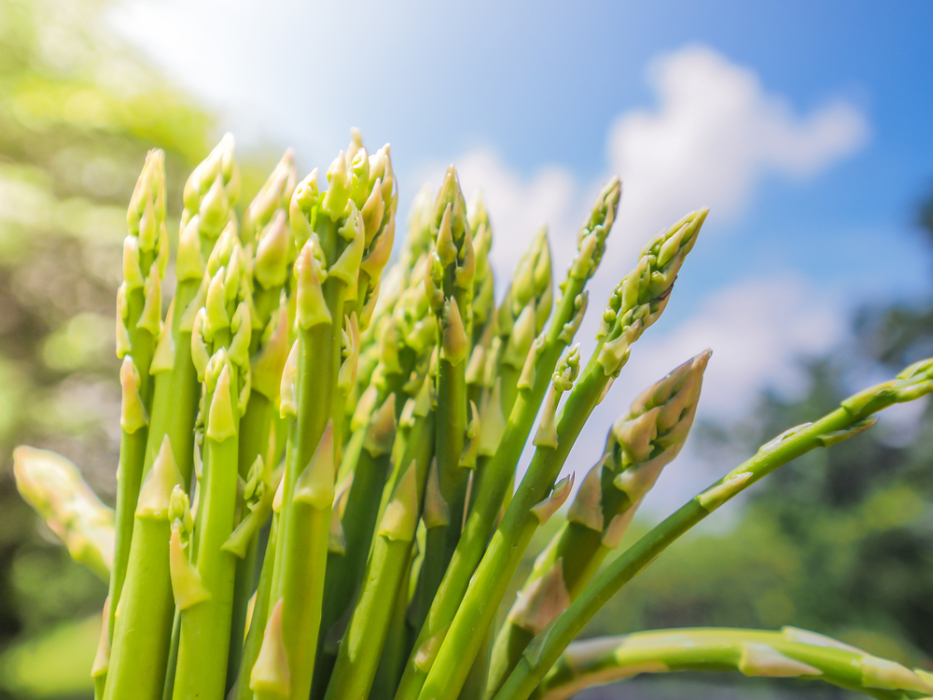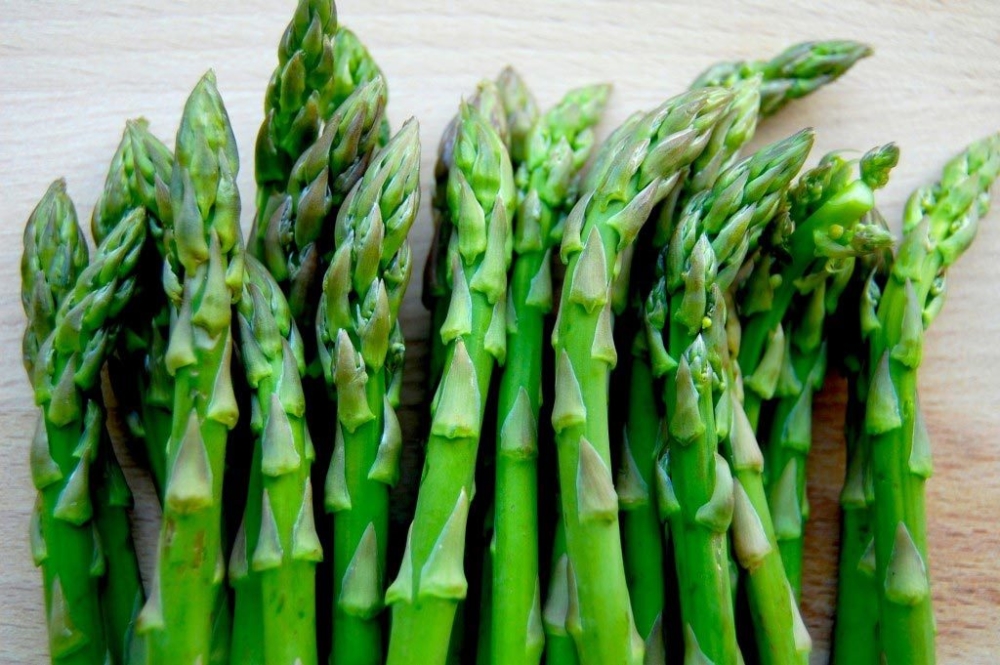Asparagus, which is often used to decorate bouquets, is known to many. But not everyone knows that cute openwork panicles are the aerial part of a plant grown in ancient times and called the “royal vegetable” because of the high price. This is medicinal asparagus - a vegetable crop, which is now recognized as a delicacy.
Material Content:
Botanical description and distribution of the plant
Asparagus officinalis belongs to the genus Asparagus (Asparagus). Description of the species and its main characteristics:
- The plant is herbaceous, perennial, dioecious.
- A well-developed root system consists of a horizontally located rhizome with thick roots extending 4-6 m deep and storing nutrients for the underground and aboveground parts of the plant. From the middle of the root, stems and buds begin, from which tasty and healthy shoots grow next year.
- The stems are green, up to 200 cm high, highly branched, straight, with many branches pointing upward.
- The leaves resemble small scales, cladodies grow in their sinuses - bundles of filiform processes not more than 3 cm long, which function like leaves and are adapted for drought.
- Dioecious flowers resembling bells appear on the male and female parts of the plant.
- The shoots that form in the ground are white, so this asparagus is called bleached. In the light they turn green.
- The fruits are small berries, red-brown, with 1-2 seeds inside.
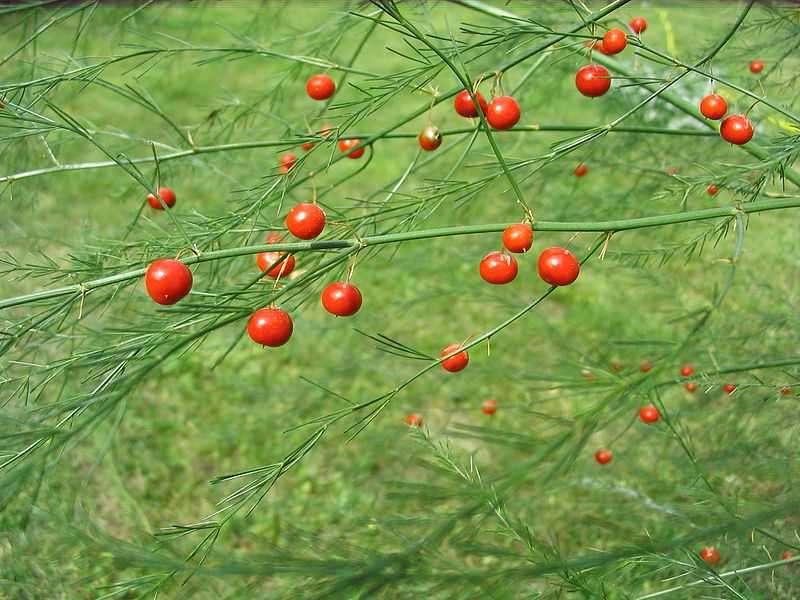 Wild asparagus is found everywhere in temperate zones. Widely cultivated in America and Western Europe. In Russia, it grows in floodplain meadows, forest edges and in grassy places. Rich and light in terms of the mechanical composition of the earth are suitable for her. Raw, cold, swampy, acidic soils are unsuitable, since under such conditions the asparagus root can rot.
Wild asparagus is found everywhere in temperate zones. Widely cultivated in America and Western Europe. In Russia, it grows in floodplain meadows, forest edges and in grassy places. Rich and light in terms of the mechanical composition of the earth are suitable for her. Raw, cold, swampy, acidic soils are unsuitable, since under such conditions the asparagus root can rot.
Pharmacological properties
Asparagus is rich in asparagine, organic acids and carbohydrates. In addition, the underground part of the plant contains saponins, coumarins, carotenoids, amino acids, proteins and vitamins C, BB, PP.
Rich in protein and shoots. They have a lot of provitamin A (carotene), vitamin C (25-60 mg), mineral salts, lysine and other amino acids.
The grass contains glycoside coniferin, tyrosine.
The benefits of medicinal asparagus for the body
The beneficial substances that make up the plant have a beneficial effect on the human body:
- coumarin is characterized by versatile pharmacological activity, exhibits an antispasmodic, antitumor effect;
- saponin promotes the discharge of sputum from the bronchi with inflammation of the respiratory tract;
- carotene is a good immunomodulator and adaptogen;
- vitamins PP and B9 (folic acid) are needed for the development of the circulatory system, they improve blood microcirculation in small vessels;
- Asparagine is the most common naturally occurring amino acid. First isolated from asparagus juice at the beginning of the 19th century. Asparagine is present in significant quantities in asparagus, hence the name. On its basis, asparaginase is obtained - an antitumor agent. This component is necessary for the activity of the nervous system.
Outdoor cultivation and care
Asparagus, like many perennials, is propagated by dividing the rhizome. It is important that the sedimented portion has 3-5 buds and several roots 12-15 cm long.
The culture can also be grown from seeds. Planting asparagus for seedlings is carried out according to the standard scheme:
- In early April, the seeds are placed for a week in warm water (35-40 ° C), which is changed every day and monitored so that it does not cool down (for example, they are placed near the battery).
- Then the wet seeds are transferred to a wet rag for germination, preventing drying out.
- Hatching sprouts are sown in a mixture: 2 parts of garden soil, 1 part of peat, manure and sand.
- Sprinkle with 2 cm of soil, regularly moisten it or cover the container with glass, ventilating daily.
- Seeds germinate well at a temperature of 25-27 ° C. After about a month and a half, the seedlings are ready for transplanting into the open ground.
In autumn, the land for planting is dug up, mineral fertilizers and manure are introduced into it. In the spring, deep (35 cm) and wide (40 cm) furrows are formed at a distance of 80-90 cm. Humus (compost) is poured into the indentations with a layer of up to 20 cm and mixed with the ground. The distance between the planted sprouts is 35-40 cm. The roots of the rhizome should be 10-15 cm below the level of the furrow. Then the plants are covered with soil by 5-7 cm. In autumn, the layer is increased by 10 cm.
 Seeds prepared by the described method can be sown early in the spring immediately into the open ground with an interval of 4-5 cm, and mature plants are transplanted to a permanent place next year.
Seeds prepared by the described method can be sown early in the spring immediately into the open ground with an interval of 4-5 cm, and mature plants are transplanted to a permanent place next year.
Care and cultivation of common asparagus include regular hilling in the summer, fertilizing with mineral fertilizers in the spring, and adding humus. In autumn, dead aboveground parts are cut to ground level and mulched with a layer of 10-15 cm.
Crops begin to be harvested from three year old plants. In the spring they are high (20-25 cm) spud, and after the formation of cracks on the surface of the earth, bleached shoots are carefully raked. Stems that have reached a height of 18-20 cm are broken out, and the soil is again raked. The collection is carried out regularly for 4-6 weeks, leaving each plant 3-5 shoots for normal nutrition. Then the soil is loosened and leveled.
If you need to get green asparagus, then it is not spud. Green shoots are no worse in quality than bleached, and they contain more vitamin C and carotene.They are cut off when they reach 15-18 cm above the surface of the soil, with unblown dense heads.
Asparagus does not require transplanting 10-15 years. Adult plants are cold-resistant and do not freeze out in winter with little snow in a 30-degree frost. Shoots develop at an earth temperature of at least 10-12 ° C, but spring frosts can damage them.
Asparagus plants require good lighting. It is not recommended to cut branches for bouquets, so as not to weaken the bush.
Application in traditional medicine and cosmetology
Traditional healers use all parts of the plant. During flowering, grass is harvested. In autumn, pick berries and dig up rhizomes with roots. From the obtained raw materials make decoctions, infusions, extracts, syrups, which find the following application in medicine:
- as a diuretic for diseases of the urinary system and edema;
- with rheumatism and acne, drugs from the aerial parts and roots of the plant are used;
- with impotence and prostatitis - from the fruit.
A decoction of the root and dry aerial shoots has a good effect on the heart and the vascular system - the contraction of the heart muscle increases with a simultaneous slowdown in rhythm, and peripheral vessels expand.
In the complex treatment of atherosclerosis, neurosis and tachycardia, asparagus extract is taken. In this case, the pressure decreases for a long time.
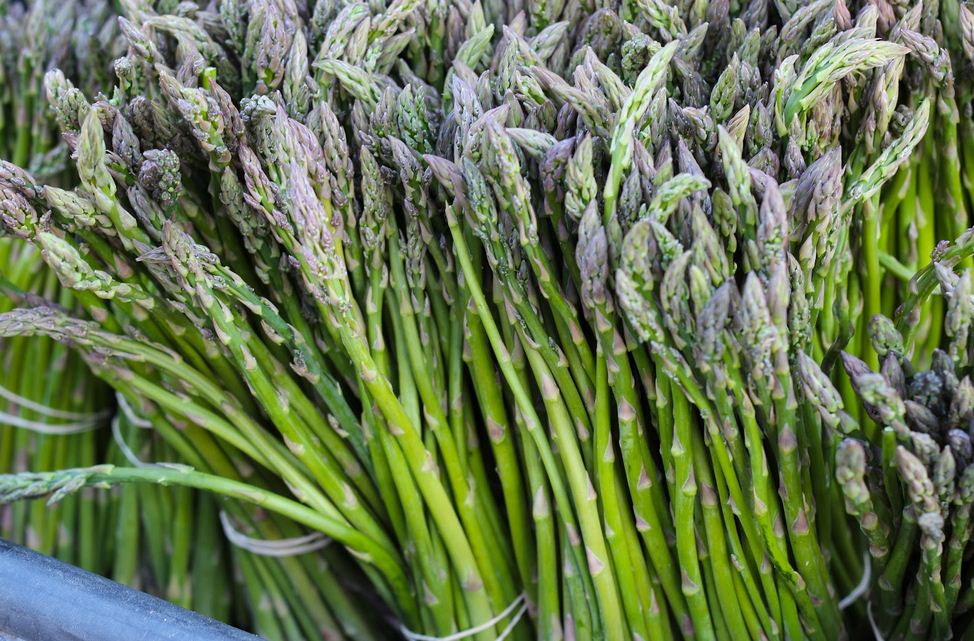 In cosmetology, lotions, decoctions, masks from the plant are used.
In cosmetology, lotions, decoctions, masks from the plant are used.
Masks for the skin of the face and neck are used both for rejuvenation and hydration, and to restore complexion. The recipes for masks are simple:
- pulp from asparagus is mixed with olive oil, any freshly squeezed juice or a dairy product (cream, cottage cheese, sour cream);
- impose on the face, neck and area under the eyes for 10-20 minutes;
- washed off with a little warm water.
They drink broth with cellulite, they also wipe their face with acne.
Cooking Asparagus - Recipes
Medicinal asparagus is a valuable food product with a specific aroma and taste. It is boiled, cooked with milk sauce or butter, baked with egg and sour cream, dried to add to vegetable soup mixes.
Before cooking, the shoots are cleaned with a sharp knife so as not to damage the heads - the most delicious part. Cook for a short time on high heat until they become soft. The main thing is not to digest the asparagus, otherwise it will lose its aroma and become watery.
Chicken fillet salad (260 kcal)
Ingredients:
- chicken fillet (150 g);
- asparagus shoots (100 g);
- fat-free cottage cheese (1 tbsp. l.);
- yogurt cheese (2 tbsp. l.);
- zest from half a lemon;
- lettuce;
- sugar, salt.
- Shoots, cut into pieces of 2 cm, are boiled in water with the addition of salt and sugar for 3-5 minutes.
- Fillet is also cut into portions and fried until cooked, without adding oil.
- To get the sauce mix cheese, cottage cheese, zest.
- To the cooled asparagus and chicken, add chopped lettuce leaves.
The mixture is seasoned with cooked sauce.
Asparagus salad with cherry tomatoes (70 kcal)
Ingredients:
- asparagus shoots (70 g);
- cherry tomatoes (6 pcs.);
- egg (1 pc.);
- medium onions (1 pc.);
- garlic (2 cloves);
- olive oil (1 tbsp. l.);
- some green onions;
- coriander, pepper;
- wine vinegar (1 tsp).
- Whole shoots are boiled in salted water.
- Poached or soft-boiled eggs are prepared from the egg.
- Finely chopped onions are fried in oil, seasoned with pepper, coriander and, if desired, Provencal herbs.
- Cherry is cut into large slices and added to the onion when it is browned.
- At the end of frying, pour vinegar, put finely chopped garlic and green onions.
Ready asparagus shoots are laid out on a dish, poured with dressing from spicy tomatoes. On top of the dish is decorated with a notched egg (with a beautifully flowing yolk).
Contraindications and side effects
Despite the undeniable benefits, there are a number of contraindications to the use of asparagus:
- individual intolerance;
- with exacerbations of peptic ulcer of the stomach or duodenum;
- during a purine-free diet.
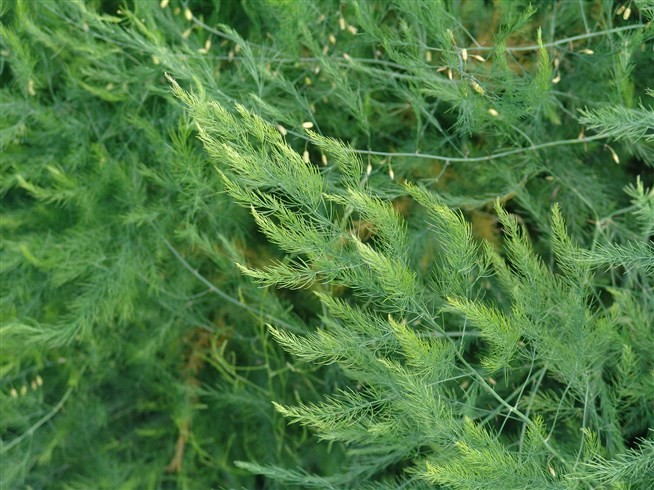 Some people suffer from hypersensitivity to this plant. The reaction may appear from the slightest touch to its parts. This phenomenon is called "asparagus scabies." And there is also an opinion that in large quantities it can cause diabetes. But this fact has not received scientific confirmation.
Some people suffer from hypersensitivity to this plant. The reaction may appear from the slightest touch to its parts. This phenomenon is called "asparagus scabies." And there is also an opinion that in large quantities it can cause diabetes. But this fact has not received scientific confirmation.
In terms of nutritional value, asparagus is superior to many vegetables and has a low calorie content. Thanks to this, it remains in demand not only by gourmets, but also by people who adhere to proper nutrition.


